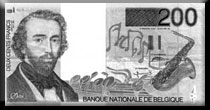


|
|
Discovering the Beginning |
|||
|
||||
|
||||
| A bass clarinet's main body is long and thick with large tone holes, and with button mechanism to control the musical notes, unlike a regular clarinet that requires human fingers to cover the apertures. A bass clarinet's bent mouthpiece and the bell section became the inspiration for Adolphe's invention of the saxophone. | ||||
In
1842, Adolphe went to the art capital Paris, where he obtained
the help of the famous classical musician Hector Berlioz and the
favorable reporting of the local media. In 1844 Adolphe finally
made a bass clarinet into a saxophone, which made its debut during
an industrial invention show in Paris. He received a patent in
1846. |
||||
At the time, classical music and opera music were very popular in Paris. Since the saxophone has good acoustical properties, its sound can completely mask the sound of other instruments. Therefore, the saxophone was not suitable for opera music or symphony music. Besides the classical musicians Berlioz and Wagner who would include saxophone in their philharmonics, only the military musicians would use saxophones. It wasn't until 1885 when American Gus Buescber obtained the right to manufacture saxophone. Jazz music benefited from the use of saxophone, and it has finally received widespread recognition thanks to the African-American population. Between 1910 and 1920, the saxophone has become the requisite instrument for a jazz music performance. Famous composers such as Glenn Miller, Benny Goodman, and Duke Ellington would always include a section for saxophone in their works. |
||||
|
||||



